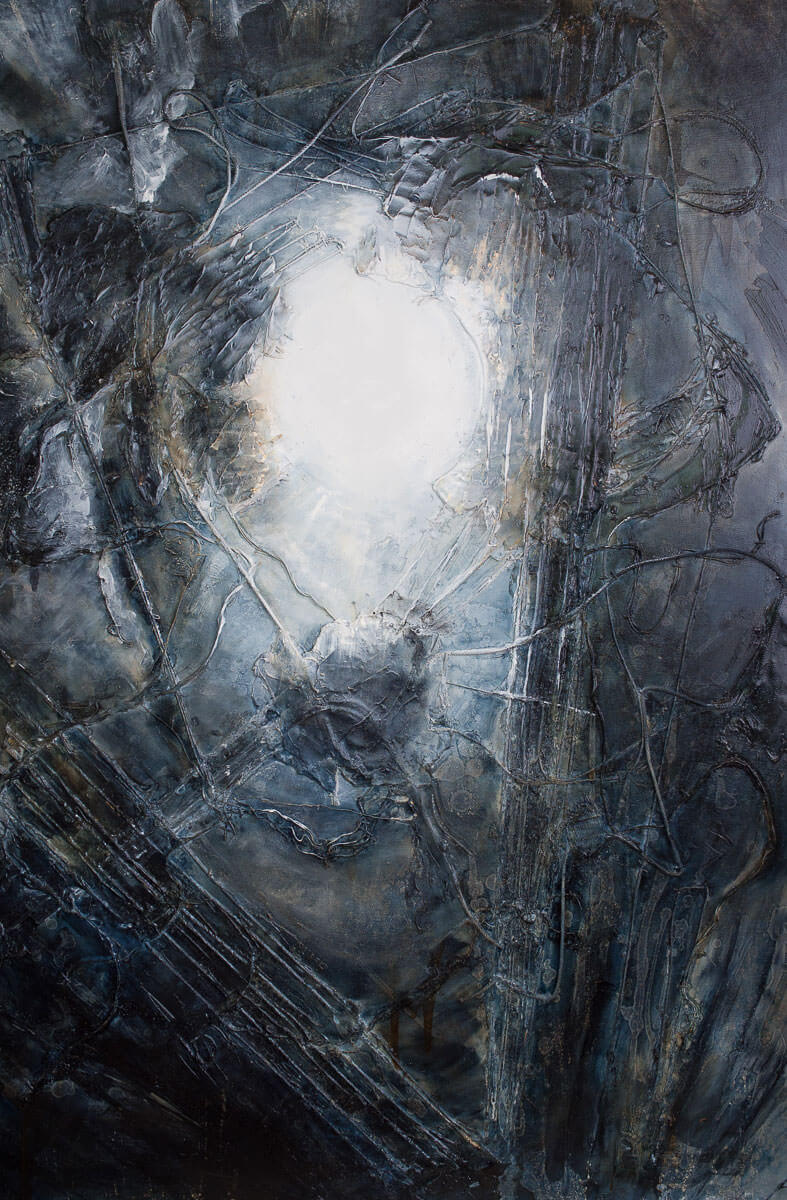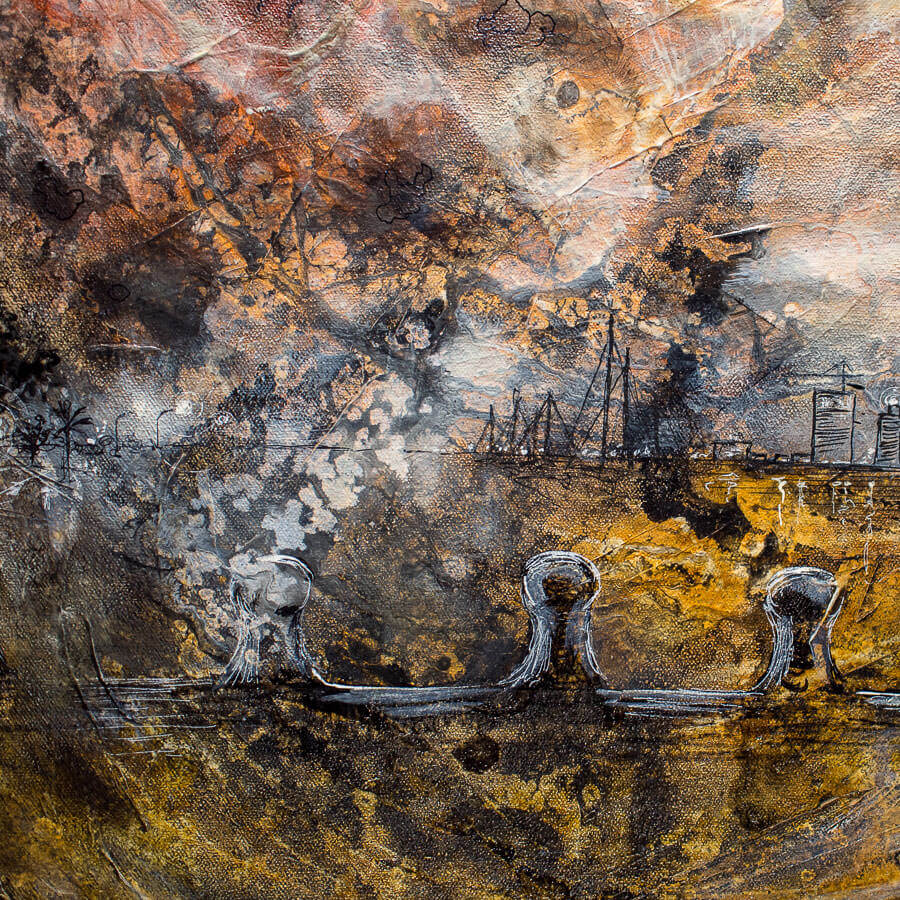
I live a small life. I teach, live alone, sing in choir, and commit Sunday evenings to family. My body, as it were, disappears into convention. But it is in the details that things get complicated: I teach religion at a Catholic all-boys’ school. I read, write, and study at the intersection of race, gender, sex, and theology. Family “gatherings” stretch four time zones, across the Pacific and into the edge of the Atlantic. For much of my life, I have straddled the center and periphery, complicated by a body at home in between belonging and other-ness.
In this essay, I reconsider the in-between as theological practice. At a time of contentious identity politics — when fetish for social location splinters an already unstable self, when claims of other-ness exacerbates paranoia/paralysis, when assertions of citizenship reveal the arbitrariness of nation — I am compelled to reconsider “time” and “place” in the constitution of subjectivity. “Place” is of particular import as we revisit the boundaries at which selfhood begins and ends. “Time”, too, requires consideration given originary claims of who first arrived, or who bears priority over land. Within these binaries, how does “in-between” — the interstice, the “third space”, the liminal(1) — reorient perceptions of self, community, and with that, claims of belonging? In this meditation, I enflesh “in-between” as a practice that slips into categories of time/space, familiarity/otherness, silence/articulation. It is a moment of ambiguity, recalling the Christian experience of the resurrection, an event that evokes not so much the promise of a world to come, but as an enduring hope that transcends imaginings of home.
Migrating Bodies
As a boy in Manila, I have often been called baklâ — effeminate, faggoty, a flamer. In the Filipino cultural universe, baklâ signifies a third gender: neither babáe (woman) nor lalake (man), embodying characteristics of both. More than a mark of sexuality, it also denotes indecision, inchoate-ness, ambiguity.(2) One who fails to commit is as baklâ as a boy (like me) who flames about town. In a sense, baklâ speaks of in-between. While there endures a negative connotation to the word, baklâ also commands recognition. I was seen, even if always in reference to what I was not supposed to be. The baklâ exists not so much as a counternarrative, but an insistent irruption into Filipino Catholic discourse.(3)
But all these shifted with geography. Moving to the United States, I found myself unable to articulate a self. Migration rendered baklâ incomprehensible. Martin Manalansán’s ethnography of Filipino gay life in New York City traces the baklâ’s tenuousness as a signifier of selfhood, ethnicity, and nation. Confronted by western sexual categories, baklâ slips into “gay” — a decidedly (effeminate) masculine space, an “ethnic” version of same-sex desire. Its reference to ambiguity dissipates, reduced into a category of sexuality, a stable (albeit, queer) self.
To the extent that migration exposed my own mis/naming, I found, too, that I was able to engage in a kind of discourse that allowed me to flirt with silence and articulation.(4) In this sense, baklâ became less an identity as a practice of becoming. In diaspora, baklâ exposed colonial tropes and the colonizers’ obsession with center. Having been exoticized/indigenized as an embodiment of (universalized) queerness, baklâ upended gender binaries. My body failed to translate: I spoke in “accents”, moved in ways that confused, conflated truth for its varied interpretations. Neither babáe nor lalake, gay nor trans, adequately Filipino nor discernibly American, I learned to navigate the undulations of geography.
Immersed as we are in debates around boundaries, walls, and citizenship, it is easy to reduce the “migrant” to an ideological figure. But perhaps in its inability to secure place and time, my migrant body illuminates, too, ancient contentions with stability. Ironically, it was from this place at the edge that I found myself drawn into the center of the Christian imaginary. In Christian theology, “home” and “belonging” allude to an originary event, but always outside the confines of time and place. Grounded in a crucified body, the Christian experience escapes historicity because of the resurrection. Indeed, the Emmaus story exposes the ephemerality of flesh configured by geography; Cleopas and his companion only come to see the resurrected Jesus in the practice of a meal, the breaking of the bread (Luke 24:13-35).(5) Having been re-incarnated beyond life/death, Jesus disorients the temporality of his body. The future becomes less about a “promise” — of what is to come — as it is a posture of enduring hope. The resurrection diminished longing for home(land), reorienting our relationship with the present. Perhaps this is why early Christians nullified distinctions between Jews and Greeks, women and men, servants and free citizens (Galatians 3:28). Transcending time and geography, they could not but live in-between. Indeed, theologian Elizabeth Stuart suggests that in its insistent sacramentality, Christianity cannot but be transtemporal. Liturgies re-member — calling forth memory, name, and community over and again. This repetitive reconstitution of body is intimate to the migrant who yearns for a home beyond the promise of fulfillment. Living in between, they lean again and again into hope bereft of guarantee; it is this insistence that stands at the heart of the resurrection.

Ambiguous Hope
The rise of Donald Trump to the forefront of the American imaginary exposed the irruption of unruly bodies into and against the discourse of heteronormativity. The proliferation of “alternative facts” magnified intersectional engagement with gender, race, class, and colonial conditions. Practices of resistance — #MeToo, Black Lives Matter, Survivors Network of those Abused by Priests (SNAP), and numerous others — exposed illusions of belonging and home(land). But these, too, blurred the chasm between victim and victimizer, forcing us to confront the accused as though they were the accuser. Trapped in cyclical finger-pointing, we wield “identities” and “social locations” as armors against the gaze of otherness. We become victims of the very ideologies we brandish to protect an elusive self.
Perhaps this is where the baklâ — as a practice of “in between” — relieves our insatiable longing for home. Escaping comprehension, the baklâ embodies the “transhistorical subject” who exists outside the limits of discourse. As a figure of ambiguity and inchoate-ness, the baklâ evokes Christian dismemberment of empire. Failing to enflesh that which is “supposed to be”, the baklâ exists in between right/wrong, belonging/displacement. Akin to the resurrection, the baklâ practices a way of being that straddles life/death, dismantling the perceived stability of enfleshment itself.
When I take a moment to reconsider the “small-ness” of my life, I unveil the ways bodies — to the extent that these are always contextualized — fail to belong. To the degree that personal experiences always rub against grand narratives, my body remains simultaneously beholden to — and irruptive of — temporality and geography. I am baklâ. There is some irony to my coming to finally incarnate this word. Used to taunt and control an unruly body, baklâ evokes, too, the fundamental impulse of Christian witness. In proximity to the memory of another body mangled and dismembered for failing to belong, the baklâ leans into an enduring hope that obsesses not so much on what ought to be, but on what could be in the here and now.
Butler, Judith. Giving an Account of Oneself. New York, NY: Fordham University Press, 2005.
Campos, Michael Sepidoza. “Social Biography: Practice of Critical Faith and Transformative Pedagogy.” In Asian North American Religion, Culture and Society. Montreal, Canada, 2009.
Foucault, Michel. The Archeology of Knowledge and the Discourse on Language. Translated by A.M. Sheridan Smith. New York, NY: Pantheon Books, 1972.
Foucault, Michel. The History of Sexuality. Translated by Robert Hurley. Vol. 1: An Introduction. New York: Vintage Books, 1990.
Kakutani, Michiko. The Death of Truth. First edition. New York: Tim Duggan Books, 2018.
Manalansán, Martin F. Global Divas: Filipino Gay Men in the Diaspora. Perverse Modernities Series. Durham: Duke University Press, 2003.
Stuart, Elizabeth. Gay and Lesbian Theologies: Repetitions with Critical Difference. Aldershot, Hampshire, England: Ashgate, 2003.
* Homi Bhabha is often associated with “third space”; Victor Turner’s work explores “liminality”; as a theoretical framework, “interstitiality” straddles literary and critical theories, philosophy, and cultural studies.
** Manalansán, Martin F. Global Divas: Filipino Gay Men in the Diaspora. Perverse Modernities Series. Durham: Duke University Press, 2003, p. 156.
*** In his introductory description of “discourse,” Michel Foucault alludes to the “irruption” of historical events—practices, if you will—that subvert and inform the perceived “unities” of an emerging narrative. See Foucault, Michel. The Archeology of Knowledge and the Discourse on Language. Translated by A.M. Sheridan Smith. New York, NY: Pantheon Books, 1972, p. 25.
**** Foucault, Michel. The History of Sexuality. Translated by Robert Hurley. Vol. 1: An Introduction. New York: Vintage Books, 1990, pp. 18-21.
***** I undertook a close reading of the Emmaus story as a practice of Christian witness in a panel presentation at the American Academy of Religion. See Campos, Michael Sepidoza. “Social Biography: Practice of Critical Faith and Transformative Pedagogy.” In Asian North American Religion, Culture and Society. Montreal, Canada, 2009.

Michael Sepidoza Campos researches at the intersection of Filipino-American diaspora, postcolonial theory, queer theory, and critical pedagogy. His writings on queer life and religion include, ‘Embracing the Stranger: Reflections on the Ambivalent Hospitality of LGBTIQ Catholics’ in More Than A Monologue: Sexual Diversity and the Catholic Church - Inquiry, Thought, and Expression (Fordham University Press, 2014); ‘The Baklâ: Gendered Religious Performance in Filipino Cultural Spaces’ in Queer Religion: LGBT Movements and Queering Religion (Praeger, 2012); and ‘In God’s House: Of Silences and Belonging,” in Theology and Sexuality, vol. 17.3 (Equinox, 2011). Campos co-edited Queering Migrations Towards, From, and Beyond Asia (Palgrave Macmillan, 2014) with Hugo Córdova Quero and Joseph N. Goh. He served as steering committee co-chair for the Asian, North American Religion, Culture, and Society Group at the American Academy of Religion. (Photo taken by Aya Tiffany Sato)

Paul Minagawa taught high school fine arts in Honolulu, HI, before working as an engineer at a Los Angeles chemical tech company. Historically a painter, his work now focuses on diagrammatic ink sketches melding engineering thinking and abstract concepts of selfishness, selflessness, and interaction between the church and the world.